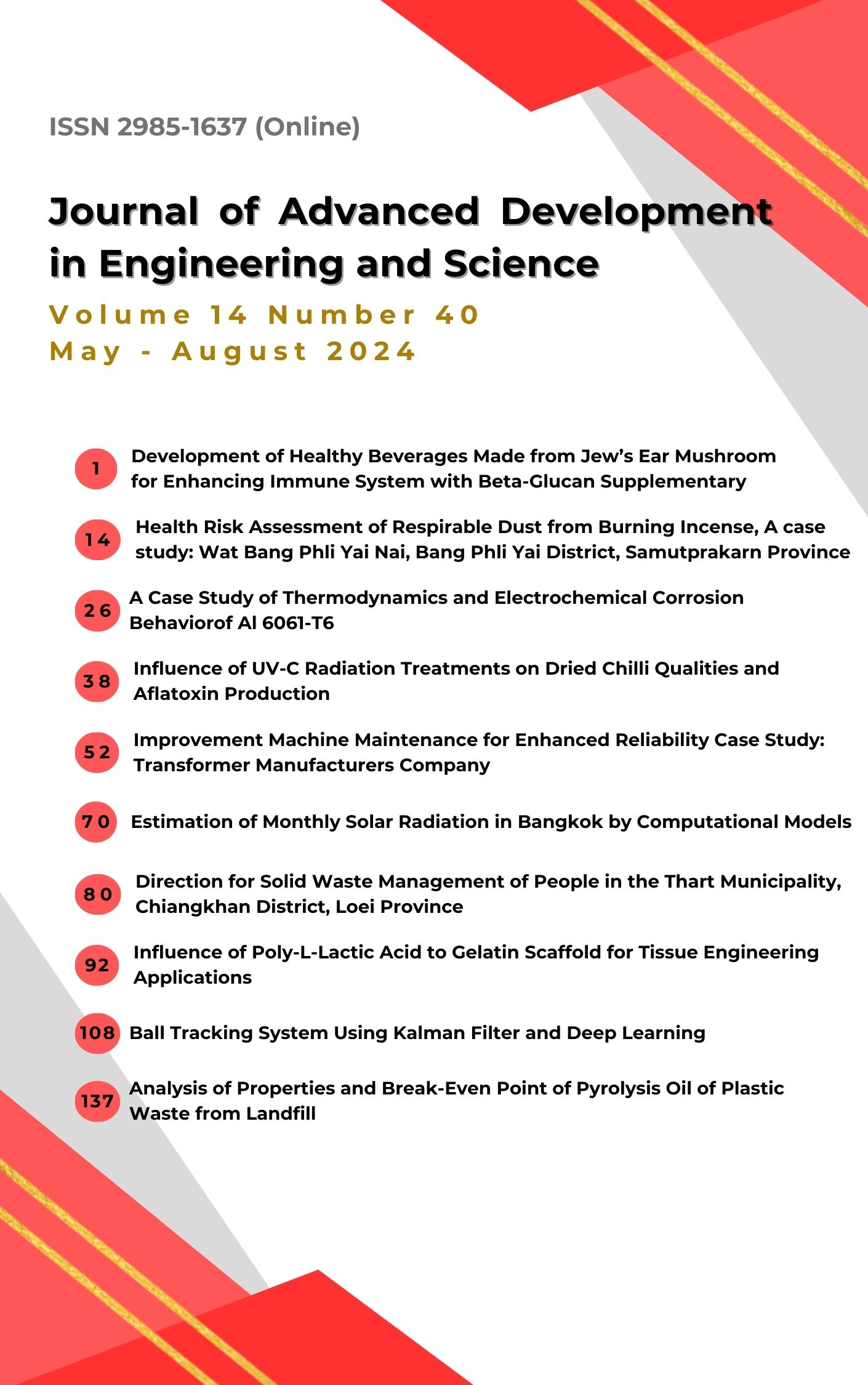Influence of UV-C Radiation Treatments on Dried Chilli Qualities and Aflatoxin Production
Main Article Content
Abstract
This study investigated the effect of UVC combined with hot air oven drying on physical quality, chemical quality and aflatoxin formation in Superhot dried chili. The experiment consisted of 3 treatments: fresh chili dried, fresh chili irradiated with UVC rays before being dried, and fresh chili dried before being irradiated with UVC rays. Drying was used a hot air oven at 70°C for 18 hours, UVC irradiated for 5, 10 and 20 minutes. 100 grams of dried chilies were packed in Poly Propylene bags and stored at room temperature for 180 days. The results of the quality analysis revealed that the moisture content of dried chili ranged from 6.91% to 9.33%. After being stored for 180 days, the moisture content and water activity of all treatment were increased significantly. Drying resulted in a decrease in L* a* and b* values, and at the end of study, L*, a*, and b* values of all treatment were probably lower than their initial values.Storage had the effect of reducing pH significantly, which was associated with an increase in titratable acidity. The detection of fluorescence from aflatoxin under black light, and quatitative of aflatoxin using ScreenEZ Aflatoxin ELISA Test Kit revealed that all treatments did not found aflatoxin.
Article Details

This work is licensed under a Creative Commons Attribution-NonCommercial-NoDerivatives 4.0 International License.
The content and information in articles published in the Journal of Advanced Development in Engineering and Science are the opinions and responsibility of the article's author. The journal editors do not need to agree or share any responsibility.
Articles, information, content, etc. that are published in the Journal of Advanced Development in Engineering and Science are copyrighted by the Journal of Advanced Development in Engineering and Science. If any person or organization wishes to publish all or any part of it or to do anything. Only prior written permission from the Journal of Advanced Development in Engineering and Science is required.
References
National agricultural big data center. (2021). Thai Food Export: Thai Instant Curry Paste Industry Fights Against COVID-19. Journal of Agricultural Economics, 67(780), 4-10. (in Thai)
Office of the permanent secretary for ministry of agriculture and cooperatives. (2020). Summary report on inspection of imported food in Australia on January to June. Available from https://www.moac.go.th/foreignagri-news-files-421691791056. Accessed date: 20 January 2023. (in Thai)
Department of trade negotiations. (2021). Thai spices and herbs go well. FTA supports exports in the first 3 months, soaring 93%. Available from https://www.ryt9.com/s/beco/ 3223891. Accessed date: 10 Febuary 2022. (in Thai)
Banmuang News. (2008). Chili Powder from Neighboring Countries Contaminated with Harmful Fungi. Available from http://www.chemtrack.org/News-Detail.asp? TID=7&ID=136. Accessed date: 10 February 2022. (in Thai)
Techawongstien, S. et al. (2015). Development of Model Community in Production Management of Safe Dried-chilli for Food Industry (Reserch report). Bangkok: Kasetsart University. (in Thai)
Chinputi, A., et al. (2006). Evaluating the Efficiency of Afltoxin ELISA Test Kit for Eventual Use by Farmer and Exporter (Research reports). Bangkok: Department of Agriculture. (in Thai)
Thai Agricultural Standard. (2010). Dried Chili Peppers. Available from https://www. acfs. go.th/standard/download/dried_chili_peppers.pdf. Accessed date: 25January 2024. (in Thai)
Vatanasuchart, N. (2003). How Does UV Radiation Benefit Food Technology?. Food Journal, 33(1), 15-22. (in Thai)
Gomez, P. L., et al. (2010). Effect of Ultraviolet-C Light Dose on Quality Of Cut-apple: Microorganism, Color and Compression Behavior. Journal of Food Engineering, 98, 60-70.
Guan, W., et al.( 2012). Effects of UV-C Treatment on Inactivation of Escherichia coli O157:H7, Microbial Loads, and Quality of Button Mushrooms. Postharvest Biology and Technology, 64, 119-125.
Pan, Y. & Zu, H. (2012). Effect of UV-C Irradiation on the Quality of Fresh-cut Pineapples. Procedia Engineering, 37, 113-119.
Suktawee, S., et al. (2012). Effect of UV-B irradiation on quality of cavendish banana. Agricultural Science Jouranl, 43(3 Suppl.). 388-391. (in Thai)
AOAC. (2000). Official Methods of Analysis. 17th ed. VA: AOAC.
Zaki, N., et al. (2013). Quality characteristics of Moroccan sweet paprika (Capsicum
annuum L.) at different sampling times. Food Science and Technology, 33(3), 577-585.
Luhadiya, A. P. & Kulkarni, P. R. (1978). Polyphenoloxidase of Capsicum Frutescens var. grossa sendt. Journal of Food Science and Technology, 15, 214-215.
Wissanee, P., et al. (2021). Color appearance and physico-chemical changes in dried chili as affected by modified atmosphere packaging and temperature during storage. Journal of Food Process and Preservative, 45(11), e15967.
Chetti, B.M., et al. (2014). Influence of vacuum packaging and long-term storage on quality of whole chilli (Capsicum annuum L.). Journal of Food Science and Technology, 51, 2827-2832.
Mangaraj, S., et al. (2001). Comparative performance evaluation of different drying
methods for chillies. Journal of the Science of Food and Agriculture, 38(3), 296-299.
Martin, S. I. F. S., et al. (2001). A review of Maillard reaction in food and implication to kinetic modeling. Trends in Food Science and Technology, 11, 364-373.
Sukchum, N., et al. (2021). Influence of Processing and Storage Conditions on Physicochemical Properties of Chili Powder and Roasted Chili Powder. RMUTP Research Journal Sciences and Technology, 16(1), 83-94. (in Thai)

